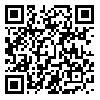Volume 4, Issue 2 (April 2020)
AOH 2020, 4(2): 548-556 |
Back to browse issues page
Download citation:
BibTeX | RIS | EndNote | Medlars | ProCite | Reference Manager | RefWorks
Send citation to:



BibTeX | RIS | EndNote | Medlars | ProCite | Reference Manager | RefWorks
Send citation to:
Pourbabaki R, Beigzadeh Z, Haghshenas B, Karimi A, Alaei Z, Yazdanirad S. Modeling of the Safety Climate and the Cultural Attitudes to Predict Unsafe Behaviors Using the Neuro-Fuzzy Inference System (ANFIS). AOH 2020; 4 (2) :548-556
URL: http://aoh.ssu.ac.ir/article-1-152-en.html
URL: http://aoh.ssu.ac.ir/article-1-152-en.html
Reza Pourbabaki1 

 , Zahra Beigzadeh1
, Zahra Beigzadeh1 

 , Behnam Haghshenas2
, Behnam Haghshenas2 

 , Ali Karimi *3
, Ali Karimi *3 

 , Zahra Alaei1
, Zahra Alaei1 

 , Saeid Yazdanirad4
, Saeid Yazdanirad4 




 , Zahra Beigzadeh1
, Zahra Beigzadeh1 

 , Behnam Haghshenas2
, Behnam Haghshenas2 

 , Ali Karimi *3
, Ali Karimi *3 

 , Zahra Alaei1
, Zahra Alaei1 

 , Saeid Yazdanirad4
, Saeid Yazdanirad4 


1- MSc, Department of Occupational Health Engineering, School of health, Tehran University of medical sciences, Tehran, Iran
2- MSc, Department of Occupational Health Engineering, School of health, Esfahan University of medical sciences, Esfahan, Iran
3- Associate Professor, Department of Occupational Health Engineering, School of health, Tehran University of medical sciences, Tehran, Iran ,a_karimi@sina.tums.ac.ir
4- PhD student, Department of Occupational Health Engineering, School of health, Tehran University of medical sciences, Tehran, Iran
2- MSc, Department of Occupational Health Engineering, School of health, Esfahan University of medical sciences, Esfahan, Iran
3- Associate Professor, Department of Occupational Health Engineering, School of health, Tehran University of medical sciences, Tehran, Iran ,
4- PhD student, Department of Occupational Health Engineering, School of health, Tehran University of medical sciences, Tehran, Iran
Abstract: (2606 Views)
Background: Unsafe behavior in industries can be due to different factors. The aim of this study was to predict and model unsafe behavior using a safety atmosphere and cultural attitudes questionnaires. Methods: This study was a descriptive-analytic and cross-sectional examination that analyzed the data and predicted the unsafe behaviors of 90 construction workers using Neuro-Fuzzy Inference System (ANFIS) in MATLAB R2016a software. Results: In this study, the model of the safety atmosphere - unsafe behavior and the model of the cultural attitudes - unsafe behavior had the regression coefficients of 0.93373 and 0.9234, respectively. It showed that each of the parameters has a close relationship to the rate of the unsafe behavior. In this regard, a combination of the safety atmosphere and safety attitude parameters for the estimation of the unsafe behaviors achieved the better results with a regression coefficient of 0.9453 which indicates the direct effect of both parameters simultaneously on unsafe behavior. Conclusion: Based on the findings, it can be concluded that the neuro-fuzzy model can be used as an appropriate tool for predicting unsafe behavior in the industries.
Keywords: Unsafe behavior, Cultural attitude, Safety atmosphere, Prediction, Neuro-fuzzy inference system
Type of Study: Research |
Subject:
Special
Received: 2019/01/14 | Accepted: 2020/04/8 | Published: 2020/04/8
Received: 2019/01/14 | Accepted: 2020/04/8 | Published: 2020/04/8
Send email to the article author
| Rights and permissions | |
 |
This work is licensed under a Creative Commons Attribution-NonCommercial 4.0 International License. |




